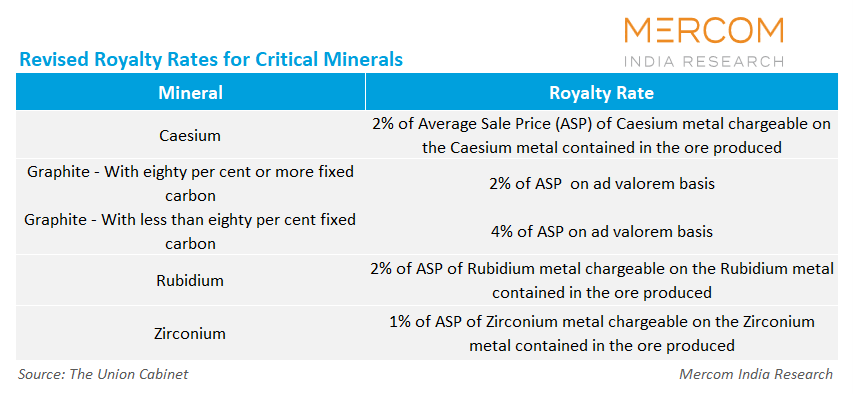Cabinet Approves Royalty Rates for Four Critical Minerals
The royalty rates range from 1% to 4% of the minerals’ average selling prices
November 13, 2025
Follow Mercom India on WhatsApp for exclusive updates on clean energy news and insights
The Union Cabinet has approved the specification or revision of the royalty rates for caesium, graphite, rubidium, and zirconium to promote the auction of blocks containing these minerals, which are used in renewable energy technologies. 
The royalty rates now range from 1% to 4% of the minerals’ average selling prices.
Recently, royalty rates of most critical minerals were specified at a range of 2% to 4%.
Graphite, caesium, rubidium, and zirconium are critical for energy transition technologies and advanced technology applications. Zirconium and graphite are also among the 24 critical and strategic minerals listed in the Mines and Minerals (Development and Regulation) Act, 1957.
The government stated that the specification/revision aims to unlock the targeted resources and associated minerals, including lithium, tungsten, rare earth minerals, and niobium.
It added that fixing royalty rates of graphite according to its value will reflect the price changes of minerals across grades proportionately. Increasing local production of such minerals will help reduce imports and mitigate supply chain vulnerabilities, while also generating employment opportunities.
In September this year, the government issued a tender for the sixth tranche of the auction for critical mineral blocks. This contained five graphite blocks, two rubidium blocks, and one block each of caesium and zirconium.
The cabinet’s approval for the royalty rates aims to help bidders submit their financial bids rationally in the auctions.
Graphite is critical for manufacturing electric vehicle batteries, serving primarily as the anode material. India imports 60% of the graphite it requires. Currently, the country has nine operational graphite mines and has auctioned an additional 27 blocks.
The Geological Survey of India and Mineral Exploration and Consultancy have handed over 20 graphite blocks for auction, with approximately 26 blocks currently being explored.
Graphite is the only mineral on the critical and strategic minerals list whose royalty rate was specified on per per-ton basis.
Due to its exceptional corrosion resistance and high-temperature stability, zirconium is utilized in multiple industries, including nuclear energy, aerospace, healthcare, and manufacturing.
In 2023, the government identified 30 critical minerals, including lithium, cobalt, nickel, graphite, and silicon, used in the renewable energy sector.
In September 2025, the Union Cabinet approved a ₹15 billion (~$170.19 million) incentive program to develop India’s recycling capacity for separating and producing critical minerals from secondary sources such as e-waste and lithium-ion battery scrap. This program is a part of the National Critical Mineral Mission, under the Ministry of Mines, which aims to build domestic capacity and supply chain resilience for critical minerals.
